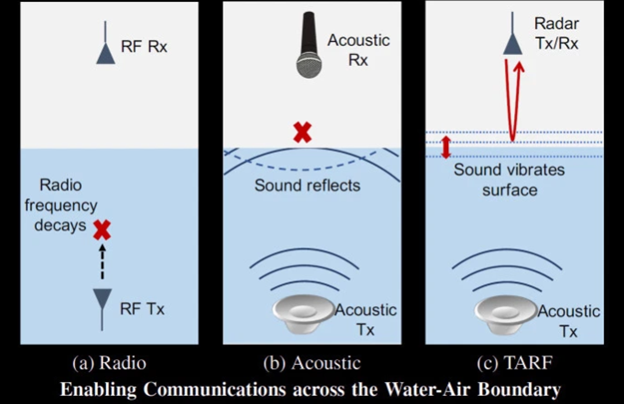an email newsletter released every month highlighting the latest articles, events, technical inquires, and voices from the community
Research Efforts in Submarine Acoustic Communications

Posted on March 30, 2020 | Completed on December 18, 2019 | By: Taylor H. Knight
Who are the key experts or organizations within the U.S. Department of Defense (DoD) involved in research efforts in maritime communications and surveillance defense-related research?
The Defense Systems Information Analysis Center (DSIAC) was asked to identify key players in the U.S. Department of Defense (DoD) research efforts in acoustic submarine communications. DSIAC searched open-source documents and the Defense Technical Information Center’s repository for relevant information, which was compiled into a report and delivered to the inquirer. Key players were organized by academia, industry, and government, followed by a summary of the research by each organization.
1.0 Introduction
Communication with submarines presents challenges within the military and can require specialized technology. Because radio waves do not travel well through saltwater, submarines often find it difficult to communicate. The DoD is actively researching these challenges.
2.0 Government Research Efforts
The following DoD organizations are performing research in acoustic submarine communications.
2.1 U.S. Naval Research Laboratory (NRL)
The NRL Acoustics Division conducts basic and applied research addressing the physics of acoustic signal generation, propagation, scatter, and detection, with the objective of improving the strategic and tactical capabilities of the U.S. Navy and U.S. Marine Corps (USMC) in the ocean and land operation environment. Research areas include physical acoustics, acoustic signal processing and systems, and acoustic simulation, measurements, and tactics. The NRL is conducting research in underwater acoustic communications and networking and long-range underwater communications [1].
The Mobile Underwater Acoustic Communications Division has developed a method for mobile underwater acoustic communications that encode a communication signal for transmitting a doubly differential-spread spectrum (DD-SS) communication output signal. The DD-SS method results in a reliable and efficient system for long-range acoustic communication [2].
2.2 Defense Advanced Research Projects Agency (DARPA)
DARPA has participated in multiple research efforts in recent years, including the Distributed Agile Submarine Hunting (DASH) program and the Positioning System for Deep Ocean Navigation (POSYDON).
The DASH program developed two prototype systems—the Transformational, Reliable Acoustic Path System (TRAPS) and the Submarine Hold at Risk (SHARK). TRAPS is a fixed passive sonar node designed to achieve large-area coverage by exploiting advantages of operating from the deep seafloor. SHARK is an unmanned underwater vehicle (UUV) designed to provide a mobile active sonar platform to track submarines after initial detection [3].
POSYDON aims to develop an undersea system that provides omnipresent, robust positioning across ocean basins. By ranging to a small number of long-range acoustic sources, an undersea platform would be able to obtain continuous, accurate positioning without surfacing for a global positioning system fix. Phase I focused on accurately modeling the signal propagation channel, Phase II focused on developing the signal waveform, and Phase III is scheduled to demonstrate a complete positioning system [4].
2.3 Office of Naval Research (ONR)
The ONR Communications and Networking Program supports basic and applied research and development of antennas, radio communications, and mobile wireless networking relevant to naval applications. This includes special-purpose submarine communication antenna systems [5].
2.4 Naval Surface Warfare Center (NSWC), Carderock Division
The NSWC Carderock Division Acoustic Research Detachment operates and supports unique large-scale submarine models, test ranges, and acoustic test facilities utilized in conducting research, development, test, and evaluation of submarine acoustic stealth technology. Future research includes critical support of current and future Navy submarine design in structural acoustics, hydroacoustics, propulsor development, and target strength reduction [6].
2.5 North Atlantic Treaty Organization (NATO) Science and Technology Organization’s Centre for Maritime Research and Experimentation
NATO sponsored research into establishing the first-ever digital underwater communications standard, JANUS. JANUS has been recognized as a NATO standard by all NATO allies since March 2017 [7]. Research has also been done describing the localization of UUVs that can be supported through networked acoustic communication [8].
2.6 Naval Information Warfare Center
The Naval Information Warfare Center’s Submarine Mast Broadband Antenna Team received an award for their research in signal intelligence capability in June 2019. The award recognized research that made significant contributions to the Navy. The team was recognized for their work in taking a speed-to-fleet capability from concept to deployment within 18 months, signaling a leap forward in signals intelligence capability and providing the Navy with a robust maritime capability [9].
3.0 Academia Research Efforts
Research at academic institutions can often result in prototypes and knowledge useful to the DoD. The following universities are conducting research that may be useful to the DoD now or in the future.
3.1 Johns Hopkins University (JHU)
JHU has performed research on deriving and validating two single-beacon acoustic navigation algorithms and developing and evaluating an acoustic communication system that enables combined communication and navigation for underwater vehicles [10].
3.2 Massachusetts Institute of Technology (MIT)
MIT Media Lab researchers have designed a system that allows underwater and airborne sensors to directly share data. The underwater acoustic transmitter directs a sonar signal to the water’s surface, causing tiny vibrations that correspond to the 1s and 0s transmitted. Above the water’s surface, a receiver reads these disturbances and decodes the signal [11]. Figure 1 displays how communications are enabled across the water-air boundary.

Figure 1: Communications Across the Water Air Boundary [12].
3.3 Woods Hole Oceanographic Institution (WHOI)
WHOI has developed the unmanned, deep-diving Nereus hybrid vehicle which can be configured as a tethered, remotely-operated vehicle using a fiber-optic cable and operate untethered as an autonomous underwater vehicle (AUV). WHOI utilizes their micro-modem which uses directional transducers on both ship and vehicle to provide the communications link. During sea trials of the Nereus in the Mariana Trench, 10 different combinations of rates, bandwidths, and carrier frequencies were tested up to 10,903 meters deep to establish the performance of each with respect to acoustic range [13].
3.4 Rutgers University
Rutgers University has researched and proposed an implicit data-compression and transmission protocol to carry out environmental monitoring missions such as adaptive sampling of physical and chemical parameters in the water. The design puts the human in the loop with semi-AUVs, allowing them to send high-level control commands [14].
4.0 Industry Research Efforts
There are multiple key players in industry who follow current research and market demands, including acoustic submarine communications. Companies are developing products to meet the demands expressed by the military and DoD.
4.1 BAE Systems
BAE Systems and Technology provided an analysis and assessment of state-of-the-art underwater acoustic data communications and technology applied to multiple vehicles in support of shallow water mine countermeasures (MCM) operations. They have researched the performance, strengths, and limitations of different approaches to acoustic communications in facilitating the overall MCM system approach [15].
4.2 Teledyne Marine
Teledyne Marine designs and manufactures rugged, reliable oceanographic instrumentation and sensor solutions for marine environments. Products include acoustic releases, acoustic telemetry modems, hydrophones, remotely-operated vehicles, glass flotation spheres, and instrument housings, and locating devices. Their Benthos Underwater Acoustic Modems transmit data wirelessly through water and are capable of high-capacity data logging, updated data storage, and user command line interfaces to real-time clock integration [16].
4.3 Elbit Systems
Elbit Systems is an international high technology company developing and supplying airborne, land, and naval systems and products for defense, homeland security, and commercial applications. They have experience in designing and developing multiple naval systems, including offering a wide range of underwater mission applications and acoustic systems.
One underwater application solution is the long-range acoustic messaging (LRAM) system. LRAM provides integrated underwater communications with submarines at long ranges while enabling tactical flexibility, such as mission changes/updates, targeting reassignment, and covert exchange of vital information in littoral waters. LRAM enhances safety by providing reliable, two-way communications with a distressed submarine. It also combines satellite communications/radio with underwater acoustic communications through an expendable buoy or persistent, unmanned surface vehicle for tactical messaging covering broad ocean areas and the shallows up to the coastline [17].
References
[1] U.S. NRL. “Acoustics Division.” https://www.nrl.navy.mil/acoustics/front, 17 December 2019.
[2] U.S. NRL. “Mobile Underwater Acoustic Communications.” https://www.nrl.navy.mil/ techtransfer/available-technologies/oceanography/mobile-underwater-acoustic-communications, 17 December 2019.
[3] DARPA. “Distributed Agile Submarine Hunting (DASH) (Archived).” https://www.darpa.mil/ program/distributed-agile-submarine-hunting, 16 December 2019.
[4] DARPA. “Positioning System for Deep Ocean Navigation (POSYDON) (Archived).” https:// www.darpa.mil/program/positioning-system-for-deep-ocean-navigation, 16 December 2019.
[5] ONR. “Communications and Networking.” https://www.onr.navy.mil/en/Science-Technology/Departments/Code-31/All-Programs/311-Mathematics-Computers-Research/ communications-networking, 18 December 2019.
[6] Naval Sea Systems Command. “Acoustic Research Detachment – Bayview, Idaho.” https:// www.navsea.navy.mil/Home/Warfare-Centers/NSWC-Carderock/Who-We-Are/Bayview-Idaho/, 16 December 2019.
[7] NATO News. “A New Era of Digital Underwater Communications.” https://www.nato.int/ cps/bu/natohq/news_143247.htm, 27 April 2017.
[8] Munafo, A., T. Furfaro, G. Ferri, and J. Alves. “Supporting AUV Localization Through Next Generation Underwater Acoustic Networks: Results From the Field.” NATO STO Centre La Spezia, United States, 1 December 2016.
[9] Petrie, P. “Naval Information Warfare Centers Win Seven ‘Top Scientists, Engineers’ Awards.” Naval Information Warfare Center, https://jnlwp.defense.gov/Press-Room/In-The-News/Article/1983464/naval-information-warfare-centers-win-seven-top-scientists-engineers-awards/, 13 August 2019.
[10] Webster, S. E. “Decentralized Single-beacon Acoustic Navigation: Combined Communication and Navigation for Underwater Vehicles.” Johns Hopkins University, Baltimore, MD, 1 June 2010.
[11] Matheson, R. “Wireless Communication Breaks Through Water-Air Barrier.” MIT News Office, http://news.mit.edu/2018/wireless-communication-through-water-air-0822, 22 August 2018.
[12] Tonolini, Francesco & Adib, Fadel. (2018). Networking across boundaries: enabling wireless communication through the water-air interface. 117-131. 10.1145/3230543.3230580.
[13] Singh, S., S. E. Webster, L. Freitag, L. L. Whitcomb, K. Ball, J. Bailey, and C. Taylor. “Acoustic Communication Performance of the WHOI Micro-Modem in Sea Trials of the Nereus Vehicle to 11,000 Meters Depth.” Woods Hole Oceanographic Institution, Department of Applied Ocean Physics and Engineering, MA, 1 June 2010.
[14] Rahmati, M., A. Achana, and D. Pompili. “Compressed Underwater Acoustic Communications for Dynamic Interaction With Underwater Vehicles.” Rutgers University, Department of Electrical and Computer Engineering, New Brunswick, NJ, 11 November 2019.
[15] Shinego, M., G. Edelson, F. Menas, M. Richman, and R. Nation. “Underwater Acoustic Data Communications for Autonomous Platform Command, Control and Communications.” BAE Systems and Technology, Nashua, NH, 12 February 2001.
[16] Teledyne Marine. “Acoustic Modems.” http://www.teledynemarine.com/acoustic-modems, 16 December 2019.
[17] Elbit Systems. “LRAM – Long-Range Acoustic Messaging.” https://elbitsystems.com/ products/naval-systems/underwater-application-solutions/long-range-acoustic-messaging/, 18 December 2019.
Want to find out more about this topic?
Request a FREE Technical Inquiry!

